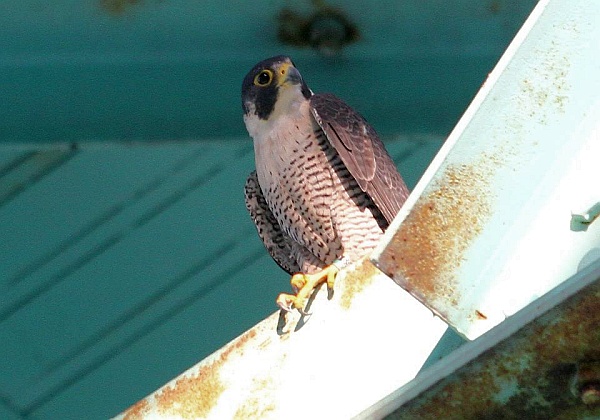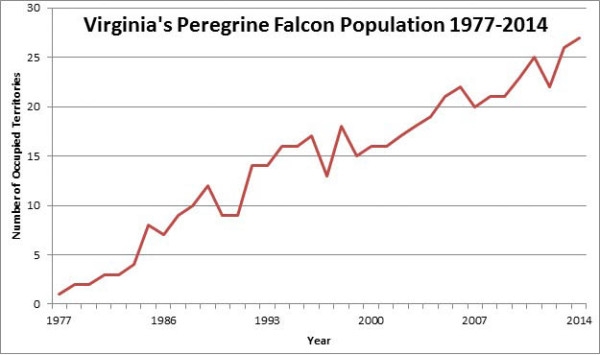
Last week William & Mary’s Center for Conservation Biology (CCB) published news of Virginia’s peregrine falcons in 2014.
As in Pennsylvania, Virginia’s breeding peregrine population has climbed from zero in the early 1970s to a nest count that matches the pre-DDT days. But just as in Pennsylvania most peregrines don’t nest in the mountains anymore.

In the report Libby Mojica of CCB writes, “Virginia’s falcon population is predominantly on the coastal plain with 24 breeding pairs on the coast including 10 [man-made] peregrine towers, 1 ground nest, 8 bridges, 1 Coast Guard navigation tower, 2 fishing shacks, 1 power plant stack, and 1 high-rise building. The population in the western part of the state remains small with only 3 pairs nesting on rock cliffs.”
Because of strong winds fledgling mortality is high at Virginia’s peregrine bridges so each year CCB, in cooperation with VDOT, translocates some of the bridge fledglings to hack boxes in the Shenandoah Mountains. This gives the young peregrines a better chance at life and may even persuade a few to nest in the mountains.
“Hope,” who nests at the Tarentum Bridge, was one of those translocated birds. She hatched on the Benjamin Harrison Bridge in Hopewell, Virginia in 2008 and was hacked in the Shenandoahs but she didn’t stay there long. Instead she flew nearly 200 miles northwest to nest on a bridge over the Allegheny River. We’re happy to have her!
Click here or on the population graph to read more about Virgina’s peregrine falcons in 2014. Scroll down to see a photo of a ground-nesting peregrine on the sand dunes.
(photo of “Hope” by Sean Dicer. Graph of Virginia’s breeding peregrines courtesy of the Center for Conservation Biology)
Thanks for posting, Kate.
My thoughts on the natural sites not fairing well. I really wonder if the DDT was the final straw in their collapse, but not the total cause of it? Does it seem strange to anyone else, that the areas they nested origionally, had “pigeons” going through by the millions, before the late 1890’s extinction of the passenger pigeon?
And now, the peregrines are gravitating to areas with their favoured prey the “pigeon” that has been introduced, and can be found, not in the forest, like the passenger pigeon was, but the cities, towns, and waterways. Right where the peregrines are now found.
I hope Not to seem all inclusive, but just some food for thought.
Wonder why the pair chose to nest in the dunes? Closer to prey?
Chad, that’s an intriguing idea about pigeons as prey.